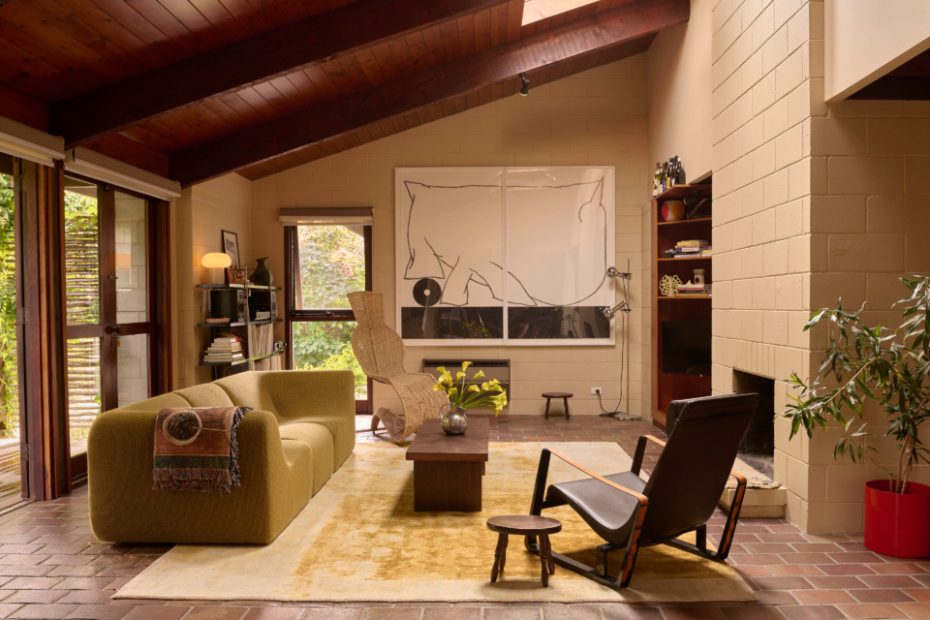An Artist’s 1970s House Turned Poetic Family Home
Homes
Cité armchair designed by Jean Prouvé. Sofa by Monde. Bolide Chair by Tom Dixon. Artwork by Julian Hocking. ‘Julian is a dear old friend, and the piece really anchors the space. It’s bold and simple and, quite frankly, doing a lot of heavy lifting,’ says Sunni.
Sunni Hart, Peter Baxter, Fox (11) and Dizzy (6) in their backyard.
Blanket by PAM x Rough Rice. Sofa by Monde. Clay sculpture of Sunni giving birth by Amy Leeworthy. Painting on top of piano from Buku Larrnggay Mulka Centre.
Bolide Chair by Tom Dixon. Vintage Enetri shelf by IKEA. Photo on shelf by Shannon May Powell. Green jug by Softedge Studio. Sofa by Monde. ‘It’s locally made, sustainable, sculptural, and incredibly comfortable. I wasn’t sure about the chartreuse at first, but now it feels perfect. Soft and a bit unexpected,’ says Sunni of the Monde sofa.
Vintage Enetri shelf by IKEA. Photo on shelf by Shannon May Powell. Green jug by Softedge Studio.
‘The Bar’ photograph by Sonia Payes. Sofa by Monde. Painting on top of piano from Buku Larrnggay Mulka Centre. Cité armchair designed by Jean Prouvé. Blanket by PAM x Rough Rice. Vitra Standard Chairs, designed by Jean Prouvé. Teak table by Nipu Møbler. Ramona side table Il Grotto.
Original 1970s ceramic tiles on the kitchen splashback.
‘The ceramic tiles are original Daniel Robertson tiles made by brickmakers who, in the mid 60s to 70s, began experimenting with heavily glazed finishes that were unlike anything else available in Australia at the time,’ says Sunni.
The house was originally designed by architect Alan Hough for artist Bruno Leti.
Like the house itself, the styling is earthy but not neutral, incorporating warm tones of copper, red, moss, indigo, silver, and cream.
The property’s generous home office.
The same ceramic tiles as the kitchen feature in the bathroom.
Sunni and Peter have styled the home to honour its existing character while making it feel like ‘them’.
The 1970s house exterior.
‘We often spill outside for an alfresco dinner under greenery, grilling on the hibachi with friends as the light fades. It’s when the house feels most alive,’ says Sunni.
Sunni Hart, founder of Tender Spaces, speaks poetically about her family home in Balwyn North.
Designed by architect Alan Hough in the 1970s, the house was originally created for artist Bruno Leti: a prolific painter and printmaker with a deep sense of aesthetic and materiality. ‘You can really feel his influence in the design,’ says Sunni.
It was this history that attracted Sunni and her partner Peter Baxter, founder of Hope St Radio, to the property. After renting a 1970s Alistair Knox house in Eltham for years prior, the couple were seeking an equally special home to continue raising their two children Fox (11) and Dizzy (6).
‘We weren’t too attached to a particular area — we were open to moving for the right house,’ says Sunni. ‘It ticked all the boxes: mid-century, architecturally designed, across from a park, full of natural light and original details, plus it has a big studio out the back which I use for my practice.
‘We love the way the light moves through the rooms, the balance of open and closed spaces, the Daniel Robertson tiles — it all feels intentional. Functional and poetic. You can tell beauty and practicality were given equal weight in every decision.’
Sunni and Peter have styled the home to honour its existing character while making it feel like ‘them’. Their furniture balances aesthetics with day to day practicalities, ensuring the house always feels comfortable and safe for Fox and Dizzy.
‘It holds our rhythms, school mornings, dinner parties with friends, quiet moments with a book, piano singalongs, Nerf gun fights, and everything in between,’ says Sunni.
Peter is obsessed with a bargain, while Sunni will splurge on the perfect piece. Together, they balance each other out, resulting in a mix of design classics with secondhand finds and pieces made by talented friends.
Like the house itself, the palette is earthy but not neutral, incorporating warm tones of copper, red, moss, indigo, silver, and cream.
‘The kids move through the space like they own it, which feels important. It’s not overly styled, but it has personality. It feels multipurpose, open, and playful,’ says Sunni.
‘It’s a lived-in home with layers. A little eccentric, a little new age, with a few kooky shapes and unexpected details that give it personality.’
Sunni and Peter have collected several of Bruno Leti’s books, and have one of his artworks hanging in the dining room in homage to the property’s past. It’s a legacy the family are proud to uphold as the home’s current custodians.
Sunni says, ‘Living here, you really get the sense that the house was built to hold art and support a creative life.’
